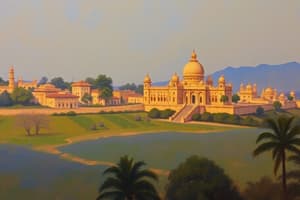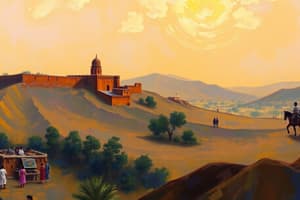Podcast
Questions and Answers
What are the two major geographic features that define the landscape of Rajasthan?
What are the two major geographic features that define the landscape of Rajasthan?
The Thar Desert and the Aravalli Range
What are some notable examples of Rajasthan's architectural brilliance that demonstrate its rich history?
What are some notable examples of Rajasthan's architectural brilliance that demonstrate its rich history?
Historical forts, palaces, and monuments
How does the arid climate of Rajasthan impact its agricultural practices?
How does the arid climate of Rajasthan impact its agricultural practices?
Agriculture in Rajasthan is largely dependent on rainfall, leading to the prevalence of dryland farming techniques.
What is the main source of income for the people of Rajasthan?
What is the main source of income for the people of Rajasthan?
What are the key factors that contribute to Rajasthan's cultural identity?
What are the key factors that contribute to Rajasthan's cultural identity?
What is the significance of the Rajput warriors in Rajasthan's history?
What is the significance of the Rajput warriors in Rajasthan's history?
What are some examples of mineral resources found in Rajasthan?
What are some examples of mineral resources found in Rajasthan?
How do festivals and rituals play a role in Rajasthan's cultural landscape?
How do festivals and rituals play a role in Rajasthan's cultural landscape?
How does Rajasthan's diverse population impact the state's cultural landscape?
How does Rajasthan's diverse population impact the state's cultural landscape?
What is the significance of Rajasthan's wildlife sanctuaries and national parks for the state's ecosystem?
What is the significance of Rajasthan's wildlife sanctuaries and national parks for the state's ecosystem?
What is the function of the state government in Rajasthan's administrative structure?
What is the function of the state government in Rajasthan's administrative structure?
How do the specialized handicrafts of different regions in Rajasthan contribute to the local economy?
How do the specialized handicrafts of different regions in Rajasthan contribute to the local economy?
Explain how the architectural splendor of Rajasthan's palaces and forts reflects historical and cultural significance.
Explain how the architectural splendor of Rajasthan's palaces and forts reflects historical and cultural significance.
Why are cities like Jaipur, Jodhpur, Udaipur, and Jaisalmer significant tourist destinations in Rajasthan?
Why are cities like Jaipur, Jodhpur, Udaipur, and Jaisalmer significant tourist destinations in Rajasthan?
How do festivals contribute to the rich tapestry of Rajasthan's social fabric?
How do festivals contribute to the rich tapestry of Rajasthan's social fabric?
What are some of the key reasons for urbanization in Rajasthan?
What are some of the key reasons for urbanization in Rajasthan?
How does the geographical location of Rajasthan influence its climate and landscape?
How does the geographical location of Rajasthan influence its climate and landscape?
What role do the Rajput kingdoms play in shaping Rajasthan's history and cultural heritage?
What role do the Rajput kingdoms play in shaping Rajasthan's history and cultural heritage?
Flashcards
Rajasthan
Rajasthan
A state in northwestern India, the largest by area.
Thar Desert
Thar Desert
A significant arid region in western Rajasthan, known for sandy landscapes.
Aravalli Range
Aravalli Range
A mountain range in Rajasthan that runs from southwest to northeast.
Major Rivers of Rajasthan
Major Rivers of Rajasthan
Signup and view all the flashcards
Rajput Kingdoms
Rajput Kingdoms
Signup and view all the flashcards
Tourism in Rajasthan
Tourism in Rajasthan
Signup and view all the flashcards
Agriculture in Rajasthan
Agriculture in Rajasthan
Signup and view all the flashcards
Cultural Heritage of Rajasthan
Cultural Heritage of Rajasthan
Signup and view all the flashcards
Handicrafts in Rajasthan
Handicrafts in Rajasthan
Signup and view all the flashcards
Diverse Population
Diverse Population
Signup and view all the flashcards
Urbanization in Rajasthan
Urbanization in Rajasthan
Signup and view all the flashcards
Primary Language
Primary Language
Signup and view all the flashcards
Rajasthan's Social Composition
Rajasthan's Social Composition
Signup and view all the flashcards
State Administration
State Administration
Signup and view all the flashcards
Jaipur
Jaipur
Signup and view all the flashcards
Ranthambore National Park
Ranthambore National Park
Signup and view all the flashcards
Cultural Heritage
Cultural Heritage
Signup and view all the flashcards
Major Festivals
Major Festivals
Signup and view all the flashcards
Study Notes
Geography and Geology
- Rajasthan is located in northwestern India, bordering Pakistan to the west.
- It is the largest state in India in terms of area.
- The state's terrain is diverse, ranging from the Thar Desert in the west to the Aravalli Range in the east.
- The Thar Desert is a significant geographical feature, characterized by arid conditions and sandy landscapes.
- The Aravalli Range is a mountain range that runs through the state, with sedimentary and metamorphic rock formations.
- The state's major rivers include the Luni, Banas, and Ghaggar.
- Rajasthan experiences a predominantly arid climate, with hot summers and cool winters.
- The mineral resources include limestone, marble, and other minerals.
- Rajasthan's geographical coordinates are between longitude 69.50' E and latitude 23° 30'N.
- The approximate land area is 342,239 square kilometers.
History and Culture
- Rajasthan has a rich history, with a long lineage of Rajput kingdoms.
- Several prominent historical empires and dynasties ruled the region, each leaving their mark on the state's culture and heritage.
- The Rajput warriors were known for their bravery and chivalry, contributing significantly to Rajasthan's historical identity.
- The state's historical forts, palaces, and monuments are notable examples of architectural brilliance.
- Rajasthan's culture is deeply rooted in its traditions and practices, influencing various aspects of daily life.
- The rich textiles and craftsmanship of the state are known for their intricate designs and patterns and use of valuable materials.
- Folklore and music forms are integral to Rajasthan's cultural identity and heritage, often reflecting stories of the land, its inhabitants, and events.
- Festivals and rituals play a vital role in expressing the culture and devotion of Rajasthan's people, and are a significant part of the state's socio-religious life.
Economy
- The state's economy is primarily based on agriculture, tourism, and mining industries.
- The agriculture sector is largely dependent on rainfall, and dryland farming techniques are prevalent.
- Tourism plays a significant economic role, attracting a large number of domestic and international tourists.
- The state's mineral resources, especially marble and limestone, contribute to the mining industry.
- Employment opportunities are varied and include a mix of occupations in agriculture, mining, hospitality/tourism, and other service-related sectors.
- Some regions of Rajasthan have specialized in handicrafts or particular products relating to the craftsmanship of the area, providing an alternative source of economic benefit for local communities.
Demographics
- Rajasthan's population is diverse, with a mix of ethnic groups and communities.
- The state's significant population growth has led to increased urbanization in some areas.
- The language spoken is primarily Hindi, with other regional and minority languages present.
- The social composition includes a wide range of social groups and communities, each contributing to the rich tapestry of Rajasthan's society.
- Literacy rates may vary among different demographic groups.
- Diverse religious beliefs and practices are observed within Rajasthan, contributing to the rich tapestry of faith in the region. This also includes the different festivals which reflect the regional communities.
- Rajasthan is one of the most populated states in India.
Administration
- Rajasthan is a state in India with a specific administrative structure, including a system for governance.
- The state government is responsible for the management of various resources and aspects of public life in the state and its regions.
- The state is divided into various administrative districts.
- The governance framework ensures specific policies are implemented within the state and policies implemented by the central government.
- Public services and infrastructure like roads and transportation are administered by the state government.
Notable Cities/Places
- Jaipur, the capital city, is a major urban center known for its historical palaces and forts (e.g., Amber Fort, City Palace, Jantar Mantar).
- Jodhpur is another significant city known for its famed Mehrangarh Fort and architectural splendor.
- Udaipur is renowned for its beautiful lakeside palaces and forts (e.g., City Palace, Lake Pichola).
- Jaisalmer is a desert city famous for its impressive golden sand forts.
- Other notable cities that receive significant tourist attention include Bikaner, Mount Abu, and Ranthambore National Park.
Wildlife
- Rajasthan is home to several wildlife sanctuaries and national parks.
- The state's varied landscapes support a diverse range of wildlife, including tigers, leopards, and various bird species.
- Ranthambore National Park, Sariska Tiger Reserve, and other protected areas are vital for wildlife conservation in the region.
Important Facts
- Rajasthan is located in northwestern India, with coordinates between longitude 69.50' E and latitude 23° 30'N.
- The geographical area of the state spans roughly 342,239 square kilometers.
- The state's population is one of the largest in India.
- The state is celebrated for its rich historical and cultural heritage, and its monuments and artistic creations.
- It is a mix of vibrant tradition and modern progress.
- A variety of festivals and celebrations are a unique mark of the state.
Specific Sub-topics
- The history of different Rajput kingdoms that ruled the area.
- The architecture of various palaces and forts (e.g., Amber Fort, City Palace, Mehrangarh Fort).
- Detailed information on specific districts with their characteristic features.
- Specific details about natural resources (e.g., mineral deposits, water resources).
Studying That Suits You
Use AI to generate personalized quizzes and flashcards to suit your learning preferences.




